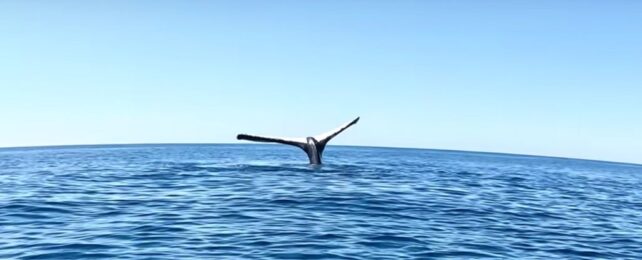An Australian TikTok celebrity has filmed a humpback whale doing a rare 'headstand' on the calm horizon.
While paddling along in a transparent kayak, Brodie Moss says the tail of a whale suddenly pierced the ocean surface ahead of him.
"My heart is beating so fast," Moss says in the background of his video, shared on TikTok and YouTube.
He gestures ahead of him at the fluted tail of a huge humpback (Megaptera novaeangliae), casually floating along on the horizon, almost entirely motionless.
"I think that's a whale tail. It's just come up and stuck its tail up, and it's not going anywhere. I don't even know what to say."
Paddling backward to keep his distance, Moss sees a baby whale swimming around the tail.
"What is it doing?" he wonders.
Moss puts his camera underwater to show the calf gently resting its head near the adult whale's chest, most likely its mother.
In the background, the two whales can be heard gently singing to each other.
https://www.youtube.com/watch?v=cVAN-5JYsGY&ab_channel=YBSYoungbloods
This odd 'tail-up' behavior is not just astounding to Moss and his TikTok fans. Scientists have wondered about it for decades now.
Because a whale's tail resembles a sail when it sticks up out of the ocean, the behavior is sometimes known as 'tail sailing'.
It's a breathtaking view only occasionally witnessed by observers of humpbacks, gray whales, bowhead whales, and right whales.
Moss did not say where he caught his footage, but he is a member of the YBS Youngbloods crew – a team that creates ocean media content on the coasts of Western Australia between Exmouth and Broome.
A whale-watching business in Western Australia also caught one of these special events on camera in 2019 and in 2020.
And that's not the only region of the world where humpbacks have shown the behavior.
Off the coast of Brazil, a long-term study of the species between 1989 and 2000 occasionally noted tail sailing, and each event ranged in time from a few seconds to as long as 12 minutes.
In most cases, experts in Brazil found the whales twisted their tails slowly, so they spun around on a longitudinal axis.
The behavior was observed among single whales, mothers, and once among a pregnant female.
When mother whales showed this behavior, their calves generally swam around them, just as Moss witnessed himself in Australia.
One calf off Brazil's coast was actually caught suckling during a tail-up event. But whale nursing can take place in other positions, too, so that doesn't fully explain the behavior.
In 2016, a drone off the coast of Maui caught sight of an erect humpback whale tail that stayed above the surface for more than 10 minutes.
A whale researcher told The Huffington Post at the time that the behavior might have to do with resting.
Similar to how humpbacks can sleep vertically in the water column, a mother whale may flip upside down to rest so she can keep an eye on her calf.
Tail sailing could also be a trick to cool down.
By sticking their bottoms up into the wind, a warm-blooded whale could theoretically help regulate its temperature.
A whale's tail, researchers note in the Brazil study, is highly vascularized, which means it could be used to absorb or release heat from the body quite effectively.
Even now, however, that hypothesis remains highly speculative.
Moss hopes his recent footage will help scientists understand the behavior better.
